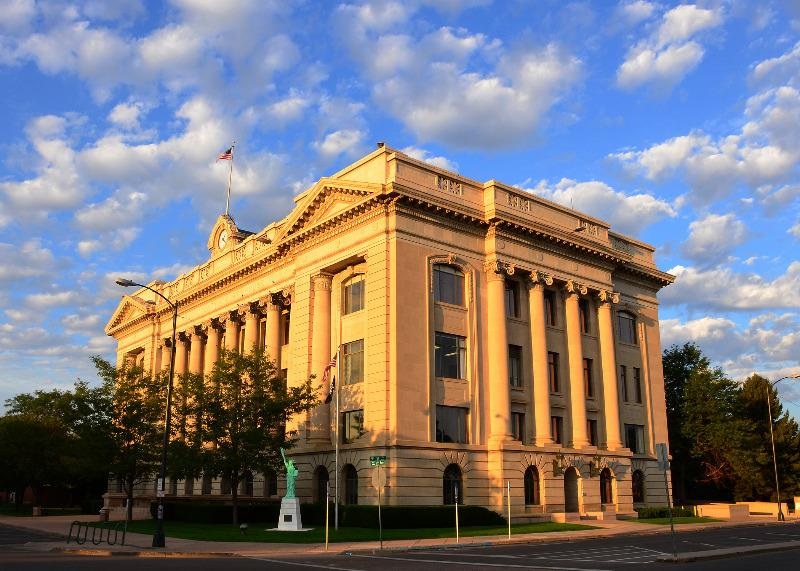The Jewel of the Plains

by Rachel Ehnert, Communications Specialist for Weld County
In the early 1900’s, Weld County was desperate for a new courthouse; the brick structure in use was quickly becoming too small to accommodate the growing county staff or the needs of the booming population. In early January of 1915, the Board of Commissioners passed a resolution to advertise for bids for the razing of the existing courthouse and they began working with renowned architect W. N. Bowman to design a new, lavish courthouse.
This new courthouse would better the old brick structure in every way—Bowman designed a towering five-story marble and limestone Classical Revival-styled structure with massive pillars and ornate interior detailing. This structure was intended to be the crowning jewel (or, as they referred to it, the “Jewel of the Plains,”) of the then second wealthiest county in the state, and it was originally expected to cost about $225,000, with taxes raised by $5.25 per every $1,000 of taxable property to pay for the building.
However, not all Weld residents were happy about this new structure, nor were they happy to have their taxes raised to pay for it. This was a contentious time for the county to choose to build a new courthouse — a handful of commissioners in the early 1900’s were accused of bribery or malfeasance (with one Commissioner, E.J. Estes, found guilty of bribery, misappropriation of funds and forgery who was sentenced to serve seven-to-nine year term.) Further, Larimer County (Weld County’s neighbor to the west) had also embarked on building a new courthouse in the late 1800’s—a courthouse, as it happened, they couldn’t actually afford. Larimer was unable to pay for the cost of construction and allowed the interest to double the cost of the courthouse before they were able to pay it off.
Despite the reluctance of some residents, the commissioners moved forward with the new building. They took bids from contractors, furniture craftsmen, window screen manufacturers, plumbers and others from all across the country, as projects of this scale were few and far between in 1915. General Contractors Seerie & Varnum won the bid to complete the structure (after the original bid winner ran out on his contract and moved to South America). The winner of the bid to complete the flooring also caused a delay in the project as parts of the floor they installed were deficient, and they demanded the commissioners pay an additional 35 cents per square foot for the replacement.
These delays were short lived, however, as by July of 1917, the structure was completed and was even more spectacular than originally planned. Bowman finished the building with elaborate hand-cast plaster depictions of ancient Greek and Roman symbols, colorful stories-high stained glass windows and even a car garage on the first floor. The final cost of the building was around $414,000, and it took only two years to complete.
This structure was more than just beautiful, however—it was also extremely innovative and practical. After years of hiring guards to watch rooms full of courthouse documents for fear that they may catch fire and burn (which was common due to the haphazard electrical technology of the day), finally the county had a 100%, absolutely fireproof courthouse. Built using steel framework and no wood at all (the only wood found in the entire building is a few railings and pieces of furniture) this building would never be subject to fire despite having both gas and electrical lighting features.
Further, this courthouse was the first in Colorado with accommodations for jurors to stay overnight—a necessity of the time, as jurors would often have to travel for miles on horseback from across the county to serve at the courthouse. Up to twelve men and six women could be accommodated in the courthouse, and they were treated to such luxuries as water heaters in the bathrooms (the building even had a women’s restroom, something of a rarity at the time).
The new building was so impressive that, despite it costing double what it was expected to, naysayers quickly quieted down. One newspaper (the Weekly Courier out of Fort Collins) even published an editorial encouraging a “Kickers Day” wherein any persons believing the courthouse to be a waste of taxpayer dollars could see for themselves what a sound use of funds it was. These people were encouraged to stick their jackknife into the brass grating to be sure it was brass, hit a wall here and there with their fist, and marvel at the beauty and structural integrity of the building.
Of course, the massive courthouse had plenty of room to house all county offices (until 1964 when renovations began and offices were moved out). The commissioners were on the second floor, with the superintendent of schools on the third floor, and the coroner and justice of the peace in the basement. In addition, the courthouse also housed what was once the third best law library in the state on the fourth floor until the books became too heavy and had to be moved into what was once the garage.
Today, most county offices have moved from the courthouse due to county growth and limited spacing. However, due to the building’s quality of design and construction, it is still in use at the official Weld County Courthouse where hundreds of legal cases are still dealt with weekly. In fact, apart from a few changes (specifically, the restoration of the stained glass, a few coats of paint, and new pieces of furniture,) the Weld County Courthouse is exactly the “Jewel of the Plains,” that it was upon its opening to the public in July of 1917, even one full century later.